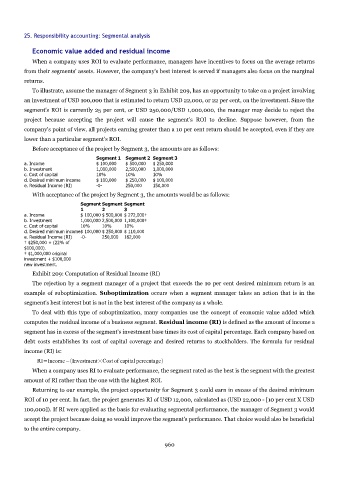Page 959 - Accounting Principles (A Business Perspective)
P. 959
25. Responsibility accounting: Segmental analysis
Economic value added and residual income
When a company uses ROI to evaluate performance, managers have incentives to focus on the average returns
from their segments' assets. However, the company's best interest is served if managers also focus on the marginal
returns.
To illustrate, assume the manager of Segment 3 in Exhibit 209, has an opportunity to take on a project involving
an investment of USD 100,000 that is estimated to return USD 22,000, or 22 per cent, on the investment. Since the
segment's ROI is currently 25 per cent, or USD 250,000/USD 1,000,000, the manager may decide to reject the
project because accepting the project will cause the segment's ROI to decline. Suppose however, from the
company's point of view, all projects earning greater than a 10 per cent return should be accepted, even if they are
lower than a particular segment's ROI.
Before acceptance of the project by Segment 3, the amounts are as follows:
Segment 1 Segment 2 Segment 3
a. Income $ 100,000 $ 500,000 $ 250,000
b. Investment 1,000,000 2,500,000 1,000,000
c. Cost of capital 10% 10% 10%
d. Desired minimum income $ 100,000 $ 250,000 $ 100,000
e. Residual Income (RI) -0- 250,000 150,000
With acceptance of the project by Segment 3, the amounts would be as follows:
Segment Segment Segment
1 2 3
a. Income $ 100,000 $ 500,000 $ 272,000†
b. Investment 1,000,000 2,500,000 1,100,000‡
c. Cost of capital 10% 10% 10%
d. Desired minimum income$ 100,000 $ 250,000 $ 110,000
e. Residual Income (RI) -0- 250,000 162,000
† $250,000 + (22% of
$100,000).
‡ $1,000,000 original
investment + $100,000
new investment.
Exhibit 209: Computation of Residual Income (RI)
The rejection by a segment manager of a project that exceeds the 10 per cent desired minimum return is an
example of suboptimization. Suboptimization occurs when a segment manager takes an action that is in the
segment's best interest but is not in the best interest of the company as a whole.
To deal with this type of suboptimization, many companies use the concept of economic value added which
computes the residual income of a business segment. Residual income (RI) is defined as the amount of income a
segment has in excess of the segment's investment base times its cost of capital percentage. Each company based on
debt costs establishes its cost of capital coverage and desired returns to stockholders. The formula for residual
income (RI) is:
RI=Income−Investment×Cost of capital percentage
When a company uses RI to evaluate performance, the segment rated as the best is the segment with the greatest
amount of RI rather than the one with the highest ROI.
Returning to our example, the project opportunity for Segment 3 could earn in excess of the desired minimum
ROI of 10 per cent. In fact, the project generates RI of USD 12,000, calculated as (USD 22,000 - [10 per cent X USD
100,000]). If RI were applied as the basis for evaluating segmental performance, the manager of Segment 3 would
accept the project because doing so would improve the segment's performance. That choice would also be beneficial
to the entire company.
960

